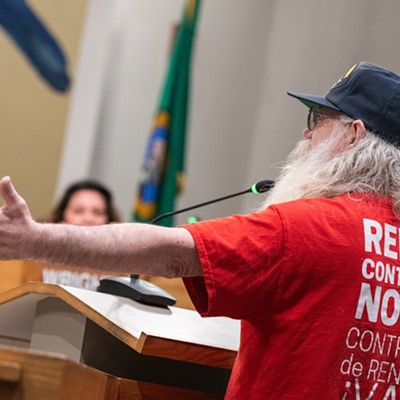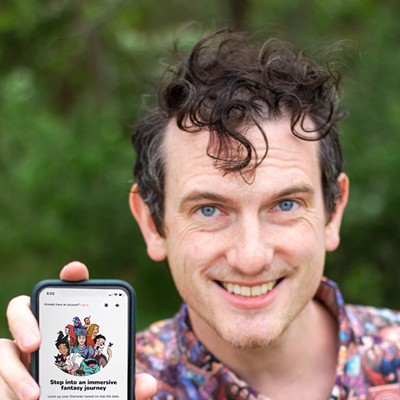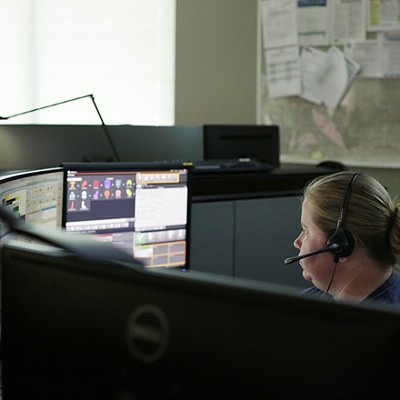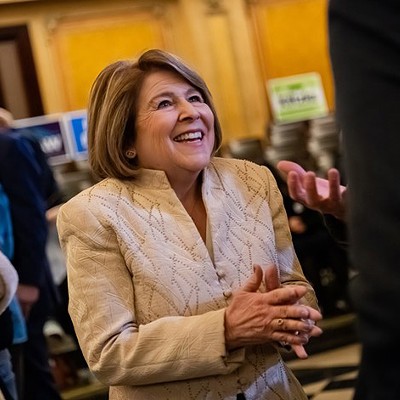Bearing Arms
[
{
"name": "Broadstreet - Instory",
"component": "25846487",
"insertPoint": "4",
"requiredCountToDisplay": "4"
},{
"name": "Broadstreet - Empower Local",
"component": "27852456",
"insertPoint": "8",
"requiredCountToDisplay": "8"
},{
"name": "Broadstreet - Instory",
"component": "25846487",
"insertPoint": "12",
"requiredCountToDisplay": "12"
},{
"name": "Broadstreet - Instory - 728x90 / 970x250",
"component": "27852677",
"insertPoint": "18",
"requiredCountToDisplay": "18"
},{
"name": "Broadstreet - Instory",
"component": "25846487",
"insertPoint": "5th",
"startingPoint": "23",
"requiredCountToDisplay": "24",
"maxInsertions": 100
}
]
by ANN M. COLFORD & r & & r & & lt;span class= "dropcap " & T & lt;/span & he first thing to know about "Samuel Colt: Arms, Art and Invention" is that it's not just for gun collectors and enthusiasts, says Curator of History Marsha Rooney.
"I call it the all-American story of capitalism and entrepreneurialism," she says. "It's the story of a guy with an idea and the ability to gather funding and supporters to put it into production, and then to market it all over the world. To me, it's an archetypal story."
The Colt story, a traveling exhibition of vintage firearms and artwork that opens this week at the MAC, illustrates the history of American industry, the growth of heavy manufacturing and production lines, and the marketing of a successful consumer product. It's about one of the first entrepreneurs to recognize the power of visual images in marketing, and one of the first to stamp his product with his own public persona.
It's the story of an inventor, a man whose early businesses failed, one whose outsized ego often clouded his better judgment and yet one who succeeded tremendously in the world of 19th-century industrial capitalism -- indeed, one who seemed destined for such success.
And at the center of these stories are the guns.
& lt;span class= "dropcap " & G & lt;/span & iven the complicated history of guns in American culture over the intervening century and a half, it's not surprising that the show has generated controversy, starting with its initial development at Connecticut's Wadsworth Atheneum. The Hartford museum met resistance from its usual funding sources and at one point took the exhibition off its calendar, until a couple of local philanthropists ponied up the entire budget for the show. Even locally, sponsorship has been a challenge, Rooney says. (Mackay Manufacturing is lead local sponsor, with additional support from the National Rifle Association.)
"It has not been easy, I think, because [guns are] such a hot topic," she says. "But ... the show is about what we're built on. And that's capitalism."
The MAC's education department has developed curriculum materials for teachers and school groups to help fill in the historical context, and Rooney says they're looking at hosting high school debates about the exhibition.
& lt;span class= "dropcap " & S & lt;/span & amuel Colt is the model 19th-century American success story. Born in 1814 in Hartford, Connecticut, he grew up in a family that saw its fortunes dwindle. While in school at Amherst Academy in Massachusetts, he got in a spot of trouble after a little incident involving gunpowder, a cannon and a wayward July 4th celebration. Soon after, at 16, he shipped out as a seaman and traveled to India. On board, the mythology goes, the locking mechanism of the ship's wheel inspired him to imagine a pistol with a revolving cylinder, allowing multiple shots before reloading. He carved a model out of wood, and when he returned stateside, he set about building a prototype.
Eventually, he found investors and set up the Patent Arms Manufacturing Company in Paterson, New Jersey, in 1836. But the timing wasn't quite right -- it was a rare time of peace -- and the company collapsed in 1842.
Colt improved his revolver design but couldn't find financing. Instead, he focused on other inventions, including a harbor defense system using underwater explosives and Samuel Morse's new telegraph cables. Finally, in 1847, he landed a contract with the federal government for 1,000 revolving pistols -- by then, the U.S.-Mexican war was on -- and he was back in business, this time in his hometown of Hartford.
From then on, Colt's business took off. By the mid-1850s, the company had constructed a huge arms factory on the banks of the Connecticut River. It was a good time for arms dealers -- the boundary survey of the 49th parallel and the 1849 California gold rush had propelled many Americans westward; Hungary was seeking independence from the Austro-Hungarian empire; the Crimean War had broken out, with Russia on one side and Britain, France and the Ottoman Empire on the other; and at home, the country was escalating toward civil war.
"He was definitely in the right place at the right time," Rooney says. "Like anything, you can look at it and think the guy was exceedingly brilliant, or you can look at it and say he was very astute and lucky in his timing."
Colt built relationships with powerful people all over the world, often with gifts of exquisite firearms -- one source estimates that he gave away 2,500 presentation guns in his lifetime. His personal charisma meant that often both sides in a battle fought with weapons from Colt.
"He worked both sides of the street in a number of international conflicts," historian William Hosley told Connecticut Public Television in a Colt documentary. "In the American West, he actually sold firearms to both the Native Americans and the American forces fighting against them."
In his factory, Colt developed state-of-the-art machining and manufacturing systems, thanks to master machinist Elisha Root, whom he hired. Colt was one of the first to run dedicated production lines and to use interchangeable machined parts among his products. Many of his techniques were picked up by other companies building consumer products like sewing machines and typewriters. A series of glass-plate slides on display shows scenes from inside the Colt factory.
And Colt was a master at marketing and self-promotion. He commissioned artist George Catlin to produce a series of oil paintings depicting Colt rifles and revolvers in the field. Catlin, who was almost as savvy a self-promoter as Colt, placed himself in the starring role in these scenes, with titles like "Catlin the Artist and Sportsman Relieving One of His Companions from an Unpleasant Predicament During His Travels in Brazil." The paintings were then made into lithographs -- inexpensive prints that could be widely distributed. Pictures of Colt's guns in action thus ended up in many homes.
Selling weapons to both sides in a conflict; giving lavish gifts to influential people in order to get more business; making expansive claims in advertising -- like it or not, these are the traits that have become synonymous with American business across the world. And Samuel Colt helped get it all started.
& lt;span class= "dropcap " & T & lt;/span & he ability to hold two opposing ideas in one's mind simultaneously is said to be a sign of a mature intellect. It's possible to admire the artistry of a Colt revolver and the inventiveness of the man himself while recognizing and acknowledging the multilayered legacy and moral ambiguity of firearms in American culture.
"[Guns are] a part of our story, like anything else," says Rooney. With Colt, she says, "A guy invents a product, markets it and makes money, but then there's the whole question of how [the product] gets used."
Maybe that question -- and the discomfort it triggers -- is what makes Colt's story such a prototypically American one.
"Samuel Colt: Arms, Art and Invention," runs Feb. 2-April 27 at the MAC, 2316 W. First Ave. Firearms expert Herbert Houze, author of the companion volume to the exhibition, will lecture on "Samuel Colt's Influence on American Industry and Advertising" in the MAC's Eric A. Johnston Memorial Auditorium on Saturday, Feb. 2, at 3 pm. Admission (includes all galleries): $7; $5, seniors; free, MAC members, teachers and students with school ID.
ALSO AT THE MAC: Merrily Tompkins
Ellensburg-based artist Merrily Tompkins makes jewelry and mixed-media assemblages that are far-fetched, amused and amusing, often tenderly personal and sometimes bawdy.
"Snatch Purse," for example, uses beaver fur. "Faith" shows a tethered figure diving in between bricked walls. "That Night" is a narrative necklace of symbols: the horse, martini glass, (getaway?) car, a comedic diamond ring. Three female torsos with miniscule abalone shells or dice for breasts tell another story-within-the story: a key and housefront; a hand, heart and flames; a belt chained to the heart. It's a familiar story told in Tompkins' trademark folksy format.
Her work spans more than 30 years and has been especially influenced by three men: her father, a former schoolteacher and inveterate tinkerer; her older brother Don, a pioneering metalsmith artist; and Ken Cory, her companion and a well-known Central Washington artist and instructor. Tompkins writes in her artist statement that her work is also informed by "passion, words, music ... irony, paradox, fate, love, humor, imperfection, reverence."
"Making art helps me make sense of and deal with the scary and exhilarating prospect of being alive and human," she writes. "It gives me a glimpse of the larger world. It is a job I like to show up for."
-- CARRIE SCOZZARO
"Merrily Tompkins: Wading in the Gulf" continues through March 4 at the MAC, 2316 W. First Ave. Hours: Tuesdays-Sundays, 11 am-5 pm. Free. Artist reception: Friday, Feb. 1, from 5-7 pm (reception continues until 9 pm). Visit www.northwestmuseum.org or call 456-3931.
"I call it the all-American story of capitalism and entrepreneurialism," she says. "It's the story of a guy with an idea and the ability to gather funding and supporters to put it into production, and then to market it all over the world. To me, it's an archetypal story."
The Colt story, a traveling exhibition of vintage firearms and artwork that opens this week at the MAC, illustrates the history of American industry, the growth of heavy manufacturing and production lines, and the marketing of a successful consumer product. It's about one of the first entrepreneurs to recognize the power of visual images in marketing, and one of the first to stamp his product with his own public persona.
It's the story of an inventor, a man whose early businesses failed, one whose outsized ego often clouded his better judgment and yet one who succeeded tremendously in the world of 19th-century industrial capitalism -- indeed, one who seemed destined for such success.
And at the center of these stories are the guns.
& lt;span class= "dropcap " & G & lt;/span & iven the complicated history of guns in American culture over the intervening century and a half, it's not surprising that the show has generated controversy, starting with its initial development at Connecticut's Wadsworth Atheneum. The Hartford museum met resistance from its usual funding sources and at one point took the exhibition off its calendar, until a couple of local philanthropists ponied up the entire budget for the show. Even locally, sponsorship has been a challenge, Rooney says. (Mackay Manufacturing is lead local sponsor, with additional support from the National Rifle Association.)
"It has not been easy, I think, because [guns are] such a hot topic," she says. "But ... the show is about what we're built on. And that's capitalism."
The MAC's education department has developed curriculum materials for teachers and school groups to help fill in the historical context, and Rooney says they're looking at hosting high school debates about the exhibition.
& lt;span class= "dropcap " & S & lt;/span & amuel Colt is the model 19th-century American success story. Born in 1814 in Hartford, Connecticut, he grew up in a family that saw its fortunes dwindle. While in school at Amherst Academy in Massachusetts, he got in a spot of trouble after a little incident involving gunpowder, a cannon and a wayward July 4th celebration. Soon after, at 16, he shipped out as a seaman and traveled to India. On board, the mythology goes, the locking mechanism of the ship's wheel inspired him to imagine a pistol with a revolving cylinder, allowing multiple shots before reloading. He carved a model out of wood, and when he returned stateside, he set about building a prototype.
Eventually, he found investors and set up the Patent Arms Manufacturing Company in Paterson, New Jersey, in 1836. But the timing wasn't quite right -- it was a rare time of peace -- and the company collapsed in 1842.
Colt improved his revolver design but couldn't find financing. Instead, he focused on other inventions, including a harbor defense system using underwater explosives and Samuel Morse's new telegraph cables. Finally, in 1847, he landed a contract with the federal government for 1,000 revolving pistols -- by then, the U.S.-Mexican war was on -- and he was back in business, this time in his hometown of Hartford.
From then on, Colt's business took off. By the mid-1850s, the company had constructed a huge arms factory on the banks of the Connecticut River. It was a good time for arms dealers -- the boundary survey of the 49th parallel and the 1849 California gold rush had propelled many Americans westward; Hungary was seeking independence from the Austro-Hungarian empire; the Crimean War had broken out, with Russia on one side and Britain, France and the Ottoman Empire on the other; and at home, the country was escalating toward civil war.
"He was definitely in the right place at the right time," Rooney says. "Like anything, you can look at it and think the guy was exceedingly brilliant, or you can look at it and say he was very astute and lucky in his timing."
Colt built relationships with powerful people all over the world, often with gifts of exquisite firearms -- one source estimates that he gave away 2,500 presentation guns in his lifetime. His personal charisma meant that often both sides in a battle fought with weapons from Colt.
"He worked both sides of the street in a number of international conflicts," historian William Hosley told Connecticut Public Television in a Colt documentary. "In the American West, he actually sold firearms to both the Native Americans and the American forces fighting against them."
In his factory, Colt developed state-of-the-art machining and manufacturing systems, thanks to master machinist Elisha Root, whom he hired. Colt was one of the first to run dedicated production lines and to use interchangeable machined parts among his products. Many of his techniques were picked up by other companies building consumer products like sewing machines and typewriters. A series of glass-plate slides on display shows scenes from inside the Colt factory.
And Colt was a master at marketing and self-promotion. He commissioned artist George Catlin to produce a series of oil paintings depicting Colt rifles and revolvers in the field. Catlin, who was almost as savvy a self-promoter as Colt, placed himself in the starring role in these scenes, with titles like "Catlin the Artist and Sportsman Relieving One of His Companions from an Unpleasant Predicament During His Travels in Brazil." The paintings were then made into lithographs -- inexpensive prints that could be widely distributed. Pictures of Colt's guns in action thus ended up in many homes.
Selling weapons to both sides in a conflict; giving lavish gifts to influential people in order to get more business; making expansive claims in advertising -- like it or not, these are the traits that have become synonymous with American business across the world. And Samuel Colt helped get it all started.
& lt;span class= "dropcap " & T & lt;/span & he ability to hold two opposing ideas in one's mind simultaneously is said to be a sign of a mature intellect. It's possible to admire the artistry of a Colt revolver and the inventiveness of the man himself while recognizing and acknowledging the multilayered legacy and moral ambiguity of firearms in American culture.
"[Guns are] a part of our story, like anything else," says Rooney. With Colt, she says, "A guy invents a product, markets it and makes money, but then there's the whole question of how [the product] gets used."
Maybe that question -- and the discomfort it triggers -- is what makes Colt's story such a prototypically American one.
"Samuel Colt: Arms, Art and Invention," runs Feb. 2-April 27 at the MAC, 2316 W. First Ave. Firearms expert Herbert Houze, author of the companion volume to the exhibition, will lecture on "Samuel Colt's Influence on American Industry and Advertising" in the MAC's Eric A. Johnston Memorial Auditorium on Saturday, Feb. 2, at 3 pm. Admission (includes all galleries): $7; $5, seniors; free, MAC members, teachers and students with school ID.
ALSO AT THE MAC: Merrily Tompkins
Ellensburg-based artist Merrily Tompkins makes jewelry and mixed-media assemblages that are far-fetched, amused and amusing, often tenderly personal and sometimes bawdy.
"Snatch Purse," for example, uses beaver fur. "Faith" shows a tethered figure diving in between bricked walls. "That Night" is a narrative necklace of symbols: the horse, martini glass, (getaway?) car, a comedic diamond ring. Three female torsos with miniscule abalone shells or dice for breasts tell another story-within-the story: a key and housefront; a hand, heart and flames; a belt chained to the heart. It's a familiar story told in Tompkins' trademark folksy format.
Her work spans more than 30 years and has been especially influenced by three men: her father, a former schoolteacher and inveterate tinkerer; her older brother Don, a pioneering metalsmith artist; and Ken Cory, her companion and a well-known Central Washington artist and instructor. Tompkins writes in her artist statement that her work is also informed by "passion, words, music ... irony, paradox, fate, love, humor, imperfection, reverence."
"Making art helps me make sense of and deal with the scary and exhilarating prospect of being alive and human," she writes. "It gives me a glimpse of the larger world. It is a job I like to show up for."
-- CARRIE SCOZZARO
"Merrily Tompkins: Wading in the Gulf" continues through March 4 at the MAC, 2316 W. First Ave. Hours: Tuesdays-Sundays, 11 am-5 pm. Free. Artist reception: Friday, Feb. 1, from 5-7 pm (reception continues until 9 pm). Visit www.northwestmuseum.org or call 456-3931.
















